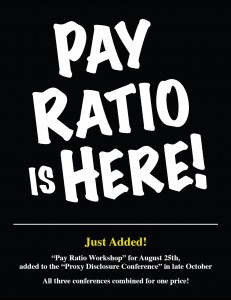Finance chiefs at public companies are looking for clarification from the Securities and Exchange Commission as they prepare to comply with coming regulations on how they must disclose the boss’s pay compared to a typical worker. The SEC earlier this month accepted public comments on a proposed rule that soon could force thousands of companies to disclose annually the ratio of CEO-to-typical worker pay. The agency first proposed the rule two years ago to comply with the Dodd-Frank Act of 2010 and SEC Chairman Mary Jo White has said she wants the SEC to issue a final rule by this fall.
Among the issues that companies are expecting to get further guidance is how they should define a “median employee”—and what types of pay to include as compensation. The clarifications also will impact the cost to companies of preparing for the ratio. The SEC is “going to have to provide some degree of guidance” to clarify which employees that companies will have to include when they crunch the numbers, said Joseph Grundfest, a Stanford law professor and former SEC commissioner.
Related
Companies can use different sampling methods in their calculations, which gives them “a lot of latitude to choose what they want those estimates to be,” said Michael Ohlrogge, a Stanford University law and engineering doctoral student, who wrote to the SEC earlier this month.
Some companies including Noble Energy Inc. are testing the waters. In March, the Houston-based oil and gas exploration and production company disclosed that former Chief Executive Charles Davidson made 82 times more than the median employee, who took home $103,500 in direct compensation in 2014. Mr. Davidson made $8.5 million in direct compensation, it said. Neither that figure nor its ratio calculation included the roughly $1 million increase in the value of his pension, employer retirement contributions and perquisites like club-membership dues the company provided. “If the SEC adopts rules on compensation ratio, we will conform the methodology by which we calculate that ratio to align with the SEC requirements,” a Noble spokeswoman said in a statement. “Until rules are adopted, we expect to continue with the current methodology in our future disclosures.”
In all, the SEC expects the 3,800 public companies affected to spend a combined $72.8 million to comply, according to its 2013 proposal. That comes to about $19,000 apiece. One “global technology company” the agency consulted estimated that the cost of crunching the numbers could amount to $350,000 plus $100,000 a year for compliance, it said. James Flaws, Corning Inc. ’s finance chief, said he expects the specialty glass and ceramics maker will lay out less than $250,000 to tally a ratio between the compensation of its CEO Wendell Weeks—$13 million in 2014—and its average worker. The Corning, N.Y. business employs 34,600 people full-time, with two-thirds of them working in more than 100 foreign countries.
At ingredients maker Ingredion Inc., based in Westchester, Ill., about 83% of the company’s full- and part-time workforce of 11,400 people is employed outside the U.S., which means that determining a pay ratio could be “resource intense,” said CFO Jack Fortnum. “There are many potential variables in the calculation of the compensation ratio, including how employees are paid around the world, and how to consider various pensions and other benefits,” he said.
A lobbyist for a S&P 500 technology company said that the company objects to including foreign employees in the calculation, because the average per capita income in places like the Philippines are a fraction of those in the U.S. and thus would skew the results.
As much as 95% of the cost and effort the company expects to face in calculating a pay ratio would arise from tallying the pay of overseas workers, he said. “If this was domestic employees only, it wouldn’t be worth my time” to fight against the rule in its current form, the lobbyist added.
The National Association of Manufacturers, a trade group, cited a member company that said it would face $18 million in costs related to implementing the rule. That unnamed company, it said, must scour 500 separate payroll systems around the world to hammer out compensation details for its 130,000 employees and build a centralized network to capture the information, according to its comment letter to the SEC. The SEC’s Division of Economic and Risk Analysis last month said the figures that companies use to calculate their pay ratios could vary between 3.4% and 15%, based on the percentage of workers the companies exclude from their sampling.
CEOs and CFOs must attest, under penalty of law, that the information is accurate, since the disclosures will be included in SEC filings, according to Timothy J. Bartl, president of the Center on Executive Compensation, a Washington, D.C., advocacy group of human-resources chiefs.
Some shareholders say they’re eager to see the new statistics. “I think the pay ratio is going to be a data point in the conversation,” said Jonas Kron, senior vice president and director of shareholder advocacy at Boston-based Trillium Asset Management LLC, with $2.2 billion in assets under management. Trillium generally votes against any executive compensation package exceeding $7 million. “We’re going to be able to have more sophisticated conversations with companies and internally when making investment determinations,” he added.
